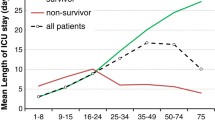Abstract
Purpose
Sepsis in severely injured patients is one of the leading causes of death in hospitals. The incidence of and risk factors for sepsis after trauma have been studied outside, but not within Korea. Therefore, this study investigated the incidence of sepsis and the independent risk factors for sepsis in moderately to severely injured patients in Korea.
Methods
The electronic medical records of patients who visited the emergency department from January 2010 to December 2012 were reviewed retrospectively. Patients older than 18 years of age with an Injury Severity Score (ISS) greater than or equal to nine points were included.
Results
A total of 183 patients met the study inclusion criteria. The median ISS was 14 (range 9–17) points and 15 (8 %) patients developed sepsis. The patients’ age [adjusted OR, 1.053; 95 % confidence intervals (CI), 1.015–1.094], ISS (adjusted OR, 1.114; 95 % CI, 1.046–1.187), and emergency surgery (adjusted OR, 3.727; 95 % CI, 1.051–13.221) were independent risk factors for post-traumatic sepsis.
Conclusions
Among the risk factors identified in the literature, our research confirmed only the patients’ age and ISS as risk factors for sepsis after trauma, and, additionally, identified emergency surgery as a risk factor in Korean patients. Therefore, trauma patients who have any of the risk factors mentioned above have a high risk of post-traumatic sepsis, which requires certain precautionary clinical measures.

Similar content being viewed by others
References
Ruchholtz S, Lefering R, Paffrath T, Oestern HJ, Neugebauer E, Nast-Kolb D, Pape HC, Bouillon B. Reduction in mortality of severely injured patients in Germany. Dtsch Arztebl Int. 2008;105:225–31.
Probst C, Pape H-C, Hildebrand F, Regel G, Mahlke L, Giannoudis P, Krettek C, Grotz MR. 30 years of polytrauma care: an analysis of the change in strategies and results of 4849 cases treated at a single institution. Injury. 2009;40:77–83.
Kahl J, Calvo R, Sise M. The changing nature of death on the trauma service. J Trauma. 2013;75:195–201.
Osborn TM, Tracy JK, Dunne JR, et al. Epidemiology of sepsis in patients with traumatic injury. Crit Care Med. 2004;32:2234–40.
Brattström O, Granath F, Rossi P, Oldner A. Early predictors of morbidity and mortality in trauma patients treated in the intensive care unit. Acta Anaesthesiol Scand. 2010;54:1007–17.
Beale E, Zhu J, Chan L, Shulman I, Harwood R, Demetriades D. Blood transfusion in critically injured patients: a prospective study. Injury. 2006;37:455–65.
Wafaisade A, Lefering R, Bouillon B, Sakka SG, Thamm OC, Paffrath T, Neugebauer E, Maegele M. Epidemiology and risk factors of sepsis after multiple trauma: an analysis of 29,829 patients from the Trauma Registry of the German Society for Trauma Surgery. Crit Care Med. 2011;39:621–8.
Bone RC. Let’s agree on terminology: definition of sepsis. Crit Care Med. 1991;19:973–6.
Annane D, Bellissant E, Cavaillon JM. Septic shock. Lancet. 2005;365:63–78.
Lenz A, Franklin GA, Cheadle WG. Systemic inflammation after trauma. Injury. 2007;38:1336–45.
Keel M, Trentz O. Pathophysiology of polytrauma. Injury. 2005;36:691–709.
Kisat M, Villegas C, Onguti S. Predictors of sepsis in moderately severely injured patients: an analysis of the national trauma data bank. Surg Infect. 2013;14:62–8.
Muckart DJ, Bhagwangee S. American College of Chest Physicians/society of Critical Care Medicine Consensus Conference definitions of the systemic inflammatory response syndrome and allied disorders in relation to critically injured patients. Cri Care Med. 1997;25:1789–975.
Giannoudis PV, Pape H-C, Smith RM. Immunity, trauma and the elderly. Injury. 2007;38:1401–4.
Valente SA, Fallon WF, Alexander TS, Tomas ER, Evancho-Chapman MM, Schmidt SP, Gorski R, Pizov O, DeFine L, Clark AJ. Immunologic function in the elderly after injury-the neutrophil and innate immunity. J Trauma. 2009;67:968–74.
Hietbrink F, Koenderman L, Rijkers G, Leenen L. Trauma: the role of the innate immune system. World J Emerg Surg. 2006;1:15.
Tschoeke SK, Ertel W. Immunoparalysis after multiple trauma. Injury. 2007;38:1346–57.
Tschoeke S, Hellmuth M, Hostmann A. The early second hit in trauma management augments the proinflammatory immune response to multiple injuries. J Trauma. 2007;62:1396–403.
Flohé S, Flohé SB, Schade FU, Waydhas C. Immune response of severely injured patients - influence of surgical intervention and therapeutic impact. Langenbecks Arch Surg. 2007;392:639–48.
Menger M, Vollmar B. Surgical trauma: hyperinflammation versus immunosuppression. Langenbeck’s Arch Surg. 2004;389:475–84.
Angele MK, Chaudry IH. Surgical trauma and immunosuppression: pathophysiology and potential immunomodulatory approaches. Langenbecks Arch Surg. 2005;390:333–41.
Papia G, McLellan BA, El-Helou P, Louie M, Rachlis A, Szalai JP, Simor AE. Infection in hospitalized trauma patients: incidence, risk factors, and complications. J Trauma. 1999;47:923–7.
Moore FA, Moore EE, Sauaia A. Blood transfusion. An independent risk factor for postinjury multiple organ failure. Arch Surg. 1997;132:620–4.
Acknowledgments
This study was partially supported by a Korea University grant and Basic Science Research Program through the National Research Foundation of Korea (NRF), funded by the Ministry of Education, Science and Technology (R1009985).
Author information
Authors and Affiliations
Corresponding author
Ethics declarations
The institutional review board for clinical research at Korea University Ansan Hospital approved the use of medical records for this retrospective study (No. AS14040).
Conflict of interest
Jong-Hak Park, Sung-Hyuk Choi, Young-Hoon Yoon, Sung-Jun Park, Jung-Youn Kim and Han-Jin Cho declare that they have no conflict of interest.
Rights and permissions
About this article
Cite this article
Park, JH., Choi, SH., Yoon, YH. et al. Risk factors for sepsis in Korean trauma patients. Eur J Trauma Emerg Surg 42, 453–458 (2016). https://doi.org/10.1007/s00068-015-0552-6
Received:
Accepted:
Published:
Issue Date:
DOI: https://doi.org/10.1007/s00068-015-0552-6




